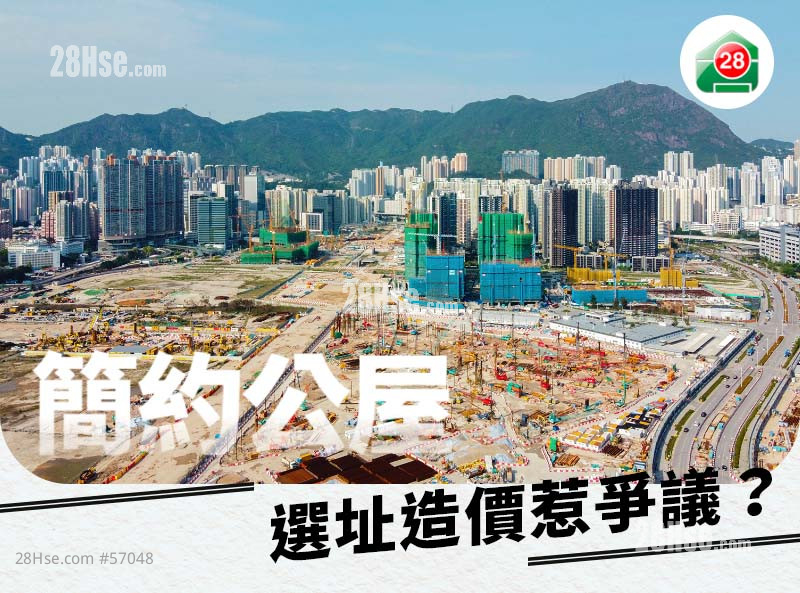In order to solve the housing problem, the government has launched ‘light public housing’ to shorten the waiting time for public housing. The project has recently been updated with the announcement of the site selection and related details. But the issues of cost and site selection issues seem to have drawn widespread attention. What happened?
The government planned to build 30,000 ‘light public housing’ units within 5 years, and announced its eight selected sites, including Sheung Ping Street/Sheung On Street in Chai Wan, Hong Kong Island; Olympic Avenue in Kai Tak and Choi Hing Road in Ngau Tau Kok, Kowloon; Tuen Mun Area 54, Tuen Mun Area 3A, Yau Pok Road, Yuen Long, Lin Tong Mei, Sheung Shui and Siu Lam in the New Territories.
Among them, the Kai Tak Olympic Avenue project aroused the most controversy, with many residents in the area opposing it. Although Kai Tak resident representatives supported the ‘light public housing’policy and the government's rational solution to the grassroots housing problem, they opposed the project's occupation of land planned for the second Core Business District (CBD2) and urged the government to correct its mistakes as soon as possible.
Kai Tak Olympic Avenue covers an area of 5.7 ha and is about a 10-minute walk from the MTR station. The 17- to 19-storey buildings will be built using the modular construction method. The project is expected to provide about 10,700 units, accounting for about one-third of the total number of projects. First, the scale is equivalent to City One Shatin.
Kai Tak Olympic Avenue covers an area of 5.7 ha and is about a 10-minute walk from the MTR station. The 17- to 19-storey buildings will be built using the modular construction method. They are expected to provide about 10,700 units, accounting for about one-third of the total project, on the same scale as City One Shatin.
The site currently has lucrative potential, but will the project affect property prices in Kai Tak? It is undeniable that the emergence of ‘light public housing’ and the conversion of commercial sites into residential developments will inevitably have an impact on property prices in the vicinity –which not only worries property owners, but also makes it difficult for developers to determine the future pricing and next steps of first-hand developments.
Fortunately, excluding the construction time, these ‘light public housing’ units will generally only be used for 5 years, after which they will be demolished and returned to the Development Bureau for commercial development. Therefore, in the long run, the project’s impact will be relatively small. In addition, the government has also promised to improve Kai Tak’s transportation facilities. This means that even when the units are demolished for commercial development, these transportation facilities will continue to be retained, which will undoubtedly benefit the development of Kai Tak.
Another point of contention is the high construction costs for ‘light public housing’. Some considered the project as a squandering of public funds and suggested that rather than demolishing the units after several years of accommodation, a more cost-effective alternative would be to provide cash subsidies to Kai Tai residents, to improve their quality of life.
The original cost of the whole project was about HK$26.79 billion. Within 30,000 units, the average cost of each unit was about HK$900,000, which is higher than the HK$650,000 of traditional public housing. Subsequently, according to latest estimate by the Architectural Services Department, the government made adjustments to reduce the overall cost of the project by some HK$950 million, with estimated costs of each unit ranging from HK$530,000 to HK$650,000. In particular, one cost-reducing measure – a decision to not provide air-conditioners for tenants – saved HK$200 million.
Amid the controversy, Legco’s Public Works Subcommittee approved the first batch of appropriations of about HK$14.9 billion for ‘light public housing’, which involved four projects including Kai Tak and Ngau Tau Kok. Judging from the current situation, the government's decision is difficult to retract. We can only hope that they will stay true to their word and that Kai Tak's positioning as Hong Kong's "second core business district" remains unchanged.
In the midst of the controversy, the Legislative Council Public Works Subcommittee finally approved the first batch of HK$14.9 billion for simple public housing, involving four projects in Kai Tak and Ngau Tau Kok. Given the current situation, the government's decision is difficult to retract. We can only hope that they will not go back on their word – and that the positioning of Kai Tak as Hong Kong’s second Core Business District remains unchanged.
If you want to know more about property's information, please click Tutorial which in our webpage.
Like 10

